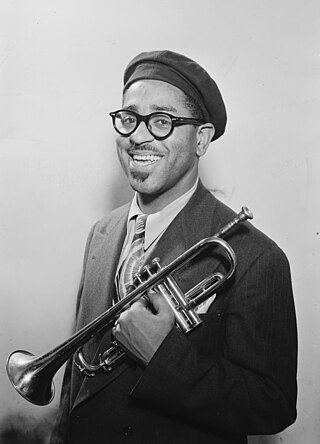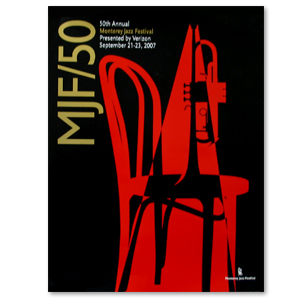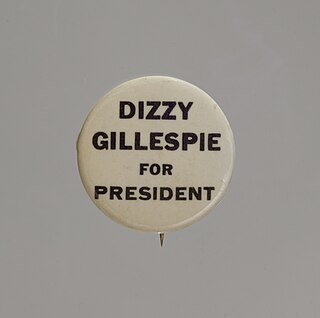
David Warren Brubeck was an American jazz pianist and composer. Often regarded as a foremost exponent of cool jazz, Brubeck's work is characterized by unusual time signatures and superimposing contrasting rhythms, meters, and tonalities.

John Birks "Dizzy" Gillespie was an American jazz trumpeter, bandleader, composer, educator and singer. He was a trumpet virtuoso and improviser, building on the virtuosic style of Roy Eldridge but adding layers of harmonic and rhythmic complexity previously unheard in jazz. His combination of musicianship, showmanship, and wit made him a leading popularizer of the new music called bebop. His beret and horn-rimmed spectacles, scat singing, bent horn, pouched cheeks, and light-hearted personality have made him an enduring icon.

Mary Lou Williams was an American jazz pianist, arranger, and composer. She wrote hundreds of compositions and arrangements and recorded more than one hundred records. Williams wrote and arranged for Duke Ellington and Benny Goodman, and she was friend, mentor, and teacher to Thelonious Monk, Charlie Parker, Miles Davis, Tadd Dameron, Bud Powell, and Dizzy Gillespie.

Earl Kenneth Hines, also known as Earl "Fatha" Hines, was an American jazz pianist and bandleader. He was one of the most influential figures in the development of jazz piano and, according to one source, "one of a small number of pianists whose playing shaped the history of jazz".

Sir John Phillip William Dankworth, CBE, also known as Johnny Dankworth, was an English jazz composer, saxophonist, clarinettist and writer of film scores. With his wife, jazz singer Dame Cleo Laine, he was a music educator and also her music director.

Cultural diplomacy is a type of public diplomacy and soft power that includes the "exchange of ideas, information, art, language and other aspects of culture among nations and their peoples in order to foster mutual understanding". The purpose of cultural diplomacy is for the people of a foreign nation to develop an understanding of the nation's ideals and institutions in an effort to build broad support for economic and political objectives. In essence "cultural diplomacy reveals the soul of a nation", which in turn creates influence. Public diplomacy has played an important role in advancing national security objectives.
Jazz is a 2001 television documentary miniseries directed by Ken Burns. It was broadcast on PBS in 2001 and was nominated for an Emmy Award for Outstanding Documentary or Nonfiction Series. Its chronological and thematic episodes provided a history of jazz, emphasizing innovative composers and musicians and American history.

The Monterey Jazz Festival is an annual music festival that takes place in Monterey, California, United States. It debuted on October 3, 1958, championed by Dave Brubeck and co-founded by jazz and popular music critic Ralph J. Gleason and jazz disc jockey Jimmy Lyons.

Jimmy Owens is an American jazz trumpeter, composer, arranger, lecturer, and educator. He has played with Lionel Hampton, Charles Mingus, Hank Crawford, Dizzy Gillespie, Count Basie, Herbie Mann, among many others. Since 1969, he has led his own group, Jimmy Owens Plus.

The Jewell Building is a city landmark in North Omaha, Nebraska. Built in 1923, it is listed on the National Register of Historic Places. Located at 2221 North 24th Street, the building was home to the Dreamland Ballroom for more than 40 years, and featured performances by many touring jazz and blues legends, including Duke Ellington, Count Basie, Louis Armstrong, Dizzy Gillespie, and Lionel Hampton.

The Real Ambassadors is a jazz musical developed in the late 1950s and early 1960s by Dave and Iola Brubeck, in collaboration with Louis Armstrong and his band. It addressed the Civil Rights Movement, the music business, America's place in the world during the Cold War, the nature of God, and a number of other themes. It was set in a fictional African nation called Talgalla, and its central character was based on Armstrong and his time as a jazz ambassador. It was the first major large scale musical collaboration between Dave and Iola Brubeck and served as a template for their future musical collaborations. Songs from the musical were recorded by Columbia Records and a soundtrack album was released in 1962, just before the show's premiere at the 1962 Monterey Jazz Festival with an all star cast.
Joseph Rupert Benjamin was an American jazz bassist.
Michael Neely Bryan was an American jazz guitarist.

The Cultural Cold War was a set of propaganda campaigns waged by the United States and the Soviet Union during the Cold War, with each country promoting their own culture, arts, literature, and music. In addition, less overtly, their opposing political choices and ideologies at the expense of the other. Many of the battles were fought in Europe or in European Universities, with Communist Party leaders depicting the United States as a cultural black hole while pointing to their own cultural heritage as proof that they were the inheritors of the European Enlightenment. The U.S. responded by accusing the Soviets of "disregarding the inherent value of culture," and subjugating art to the controlling policies of a totalitarian political system, even as they felt saddled with the responsibility of preserving and fostering western civilization's best cultural traditions, given the many European artists who took refuge in the United States before, during, and after World War II.

In the early 1940s in jazz, bebop emerged, led by Charlie Parker, Dizzy Gillespie, Thelonious Monk and others. It helped to shift jazz from danceable popular music towards a more challenging "musician's music." Differing greatly from swing, early bebop divorced itself from dance music, establishing itself more as an art form but lessening its potential popular and commercial value. Since bebop was meant to be listened to, not danced to, it used faster tempos. Beboppers introduced new forms of chromaticism and dissonance into jazz; the dissonant tritone interval became the "most important interval of bebop" and players engaged in a more abstracted form of chord-based improvisation which used "passing" chords, substitute chords, and altered chords. The style of drumming shifted as well to a more elusive and explosive style, in which the ride cymbal was used to keep time, while the snare and bass drum were used for accents. This appealed to a more specialized audiences than earlier forms of jazz, with sophisticated harmonies, fast tempos and often virtuoso musicianship. Bebop musicians often used 1930s standards, especially those from Broadway musicals, as part of their repertoire. Among standards written by bebop musicians are Gillespie's "Salt Peanuts" (1941) and "A Night in Tunisia" (1942), Parker's "Anthropology" (1946), "Yardbird Suite" (1946) and "Scrapple from the Apple" (1947), and Monk's "'Round Midnight" (1944), which is currently the most recorded jazz standard composed by a jazz musician. An early 1940s style known as "jumping the blues" or jump blues used small combos, uptempo music, and blues chord progressions. Jump blues drew on boogie-woogie from the 1930s. Kansas City Jazz in the 1930s as exemplified by tenor saxophonist Lester Young marked the transition from big bands to the bebop influence of the 1940s. These divergences from the jazz mainstream of the time initially met with a divided, sometimes hostile response among fans and fellow musicians, especially established swing players, who bristled at the new harmonic sounds. To hostile critics, bebop seemed to be filled with "racing, nervous phrases". Despite the initial friction, by the 1950s bebop had become an accepted part of the jazz vocabulary. The most influential bebop musicians included saxophonist Charlie Parker, pianists Bud Powell and Thelonious Monk, trumpeters Dizzy Gillespie and Clifford Brown, and drummer Max Roach.
The Rhythm Road: American Music Abroad is a $1.5 million per annum cultural exchange program for musicians sponsored in part by the United States State Department's Bureau of Educational and Cultural Affairs. This program is in partnership with Jazz at Lincoln Center. It provides an opportunity for American musicians to reach out to areas in the world where American society and culture are not particularly liked. Since its launch in 2005, 150 musicians have participated in the Rhythm Road, travelling to over 100 countries. The State Department draws a direct link between this program and the Jazz Ambassadors program during the Cold War era, when Jazz legends such as Dizzy Gillespie, Louis Armstrong and Dave Brubeck went on global tours on behalf of the State Department.
Christopher Columbus is an American jazz song composed by Chu Berry with lyrics by Andy Razaf. Pianist Fats Waller turned the tune into a 1936 novelty hit which was subsequently recorded by numerous other artists and became a jazz standard. Jimmy Mundy wrote the lead into a medley with "Sing, Sing, Sing" for Benny Goodman.
Penny Marie Von Eschen is an American historian and Professor of History and William R. Kenan, Jr. Professor of American Studies at the University of Virginia. She is known for her works on American and African-American history, American diplomacy, the history of music, and their connections with decolonization.

The jazz musician Dizzy Gillespie campaigned as an independent write-in candidate during the 1964 United States presidential campaign.

Soundtrack to a Coup d'Etat is a documentary film directed by Johan Grimonprez released in 2024. In the film, Jazz and decolonization are entwined in a historical rollercoaster that rewrites the Cold War episode that led musicians Abbey Lincoln and Max Roach to crash the UN Security Council in protest against the murder of Congolese leader Patrice Lumumba. It is 1961, six months after the admission of sixteen newly independent African countries to the UN, a political earthquake that shifts the majority vote from the colonial powers to the Global South. As Soviet leader Nikita Khrushchev bangs his shoe in indignation at the UN’s complicity in the overthrow of Lumumba, the US State Department swings into action by sending jazz ambassador Louis Armstrong to Congo to deflect attention from the CIA-backed coup.














